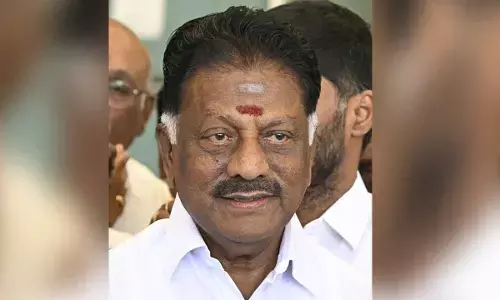Aadi Kavi Nannaya’s brilliant translation of the Mahabharata

The study of literature nourishes youth, entertains old age, adorns prosperity, solaces adversity, and is delightful at homeand, unobtrusive abroad, said Roman orator and philosopher Marcus Tullius Cicero (106-43 BC).
The study of literature nourishes youth, entertains old age, adorns prosperity, solaces adversity, and is delightful at homeand, unobtrusive abroad, said Roman orator and philosopher Marcus Tullius Cicero (106-43 BC). The literature of any country is judged by its moral standards. Great books like the Bible and the Mahabharata have served mankind as guides to its moral and literary life. They are like “capital safely invested, and richly productive of interest.”
The Indian national epic Mahabharata, written by Maharshi Veda Vyas in Sanskrit, has the power to stir souls of all sections of people for its literary excellence, philosophical flashes, moral code, wisdom, royal law, and God’s help to righteous people, to mention a few of its features. In order to bring these treasures for the benefit of Telugu people, Rajaraja Narendra (1022-1061 AD), a veteran Chalukyan ruler of Vengi, with Rajahmundry as his headquarters in the Andhra region, asked his court poet and his family’s spiritual advisor Nannaya Bhattaraka to translate the Mahabharata into Telugu to make the epic popular in the region. The king knew that the best way to popularise the scriptures was to render them into regional languages as the Buddhists and Jains used local languages for their sermons and teachings.

Here we need to look into the political background of those days. Pulakesin II (609-642 AD), of the Chalukya dynasty, was the ruler of Vatapi (Badami of Karnataka). He conquered Vengi in Andhra and appointed his brother Kubja Vishnuvardhana as the viceroy for the region. But Vishnuvardhana, in 634 AD, rebelled and established the Eastern Chalukya Dynasty in Andhra that continued for 500 years. Rajaraja Narendra, of Eastern Chalukyas, ascended the throne in 1022 AD. During his time, two literary works in Kannada – ‘Vikramarjuna Vijayam’ and ‘Gadayuddham’ – popularised the story of Sanskrit Mahabharata in Karnataka. During the seventh and eigth centuries, Tamil versions of the Mahabharata were available.
Unfortunately, at that time, the Puranas and the epics were not available in Telugu. Literature was in the hands of priests. Only some Brahmin pandits recited the Puranas and epics like the Mahabharata in temples and courts of the rulers. So, Rajaraja Narendra entrusted Nannaya Bhattu with the stupendous task of translating the Mahabharata into Telugu.
Nannaya Bhattu took up the work in right earnest in 1030 AD. He liberally mixed Sanskrit diction with the then prevailing Telugu language in his translation. He also seemed to have drawn on several characteristics of the already enriched Kannada literature. He thus evolved his own distinctive literary style, prosody and grammar. Nannaya translated Adi Parva (the first chapter), Sabha Parva, and half of Aranya Parva. And then he died. Tikkana Somayaji, another veteran Telugu scholar, completed the rest of the Mahabharata, except, of course, the leftover Aranya Parva, in the 13th century. It was rumoured that it was not auspicious to touch that leftover section (Parva). After more than 300 years, however, Yerrapragada of the 14th century completed the unfinished Aranya Parva and lived to a ripe old age.
Nannaya did not follow verbatim the original Sanskrit text. He created his own version of the epic in Telugu (Andhram) by making several modifications, additions and deletions. However, he maintained the story line. Scholars hold the view that in literary compositions there are bound to be similar ideas and for that reason they should not be condemned as plagiarism.
Out of the 18 chapters (Parvas) of the Mahabharata, the second chapter Sabha Parva is the key section around which the entire story, including the epic battle Kurukshetra Sangramam revolves. The open humiliation of the queenly woman of Pandavas, Draupadi, before all the courtiers and her husbands by the Kaurava brothers is the central point for the war. Nannaya’s delineation of this section is remarkable. The highly sophisticated and well developed language used by Nannaya implies that Nannaya’s Telugu Mahabharata may not be the origin of Telugu literature.
Unfortunately for us, the pre-Nannaya Telugu poetry or prose is extinct. Nothing is available now except some royal grants and decrees in Telugu. He thus came to be known as Aadi Kavi (the first poet) on account of his scholarly translation of a part of the Sanskrit Mahabharata. He was also conferred with the titles Sabda Saasanudu and Vaaganusaasanudu (who commands the language) after his Telugu grammar work ‘Andhra Sabda Chintamani’.
No one knows for certain about the life of Nannaya Bhattu. Some claim him to be a Vaidic Brahmin, and others say he was a Niyogi, propounding their own theories. He was the Kula Brahmin of the Vengi King, Rajaraja Narendra. He was the Rajguru. Some others say that as Chalukyas came from the western part of the country, Nannaya was a Maharashtrian Brahmin, who came along with the predecessors of Rajaraja Narendra. Though he did not mention anything about his genealogy, there is evidence in Nannaya’s Mahabharata itself to suggest that he was a Veginati Brahmin. A poem in ‘Seesa’ metrification exquisitely describes the glory of Veginadu, which was not in the Sanskrit Mahabharata. It shows his love for his country. Nannaya was well versed in the Vedas.
It goes without saying that he was equally adept in both Sanskrit and Andhram (Telugu).It is also evident from his Mahabharata that he had two popular customary names – ‘Nannapaaryu’ and ‘Nannaya Bhattu’. Some say that he was also known as ‘Nanniya’ and ‘Nannaya’ – the former being an antique form and the latter a modern form. The view of some that he was a Karnataka scholar has been contradicted by some scholars. A few others argue that he might have been a Tamilian.
Many researchers and scholars are of the opinion that Narayana Bhattu and Nannaya Bhattu were contemporaries, and Narayana Bhattu helped Nannaya Bhattu in a big way in translating the Sanskrit epic the Mahabharata. Nannaya espoused the narrative style and liberal use of Sanskrit vocabulary thus making his verses flow evenly and in a polished way. They sound more pleasing to the ear with their rhyme and rhythm resulting from the judicious use of consonants.This made his Telugu sweet and sonorous, and so Nannaya was considered the most musical of poets. The generous blend with Sanskrit really made Nannaya’s Mahabharata melodious, and it stirs the imagination of readers.
Besides the main rule of being literally faithful to the original, and the method of free-hand rendering in translations, there is a technique of ‘transcreation’.
“In this process it is not merely the representation of an idea of one medium into a different one without any distortion but at the same time the translator has a free hand to say that in his own way. This has been Nannaya’s main contribution to the literary expansion. He has blazed a new trail in this respect and this was followed by later litterataeurs. This method does not give freedom to distort the original, but the translators have the liberty to contract or expand any narrative or imagery to suit the need. In fact, to quicken the movement of the narrative this may become necessary, too. But, at the same time, they cannot represent any incident or event in such a way that may change or distract the essential qualities of the character of the original work,” according to Prof. RN Sampath.
Understandably, the Government of Andhra Pradesh in March 2006 established a unique university at Rajahmundry named after Nannaya Bhattu, who initiated the freeway authentic translation of the Mahabharata. The university aims to combine the glory of Telugu and the contemporary demands of educational excellence. Its motto is to promote competitive spirit in knowledge creation.

















